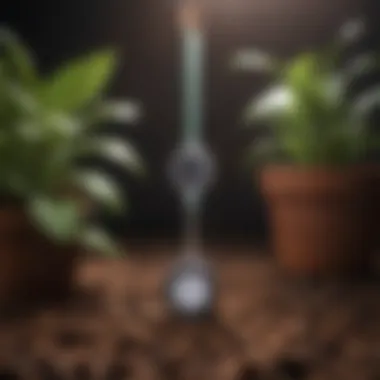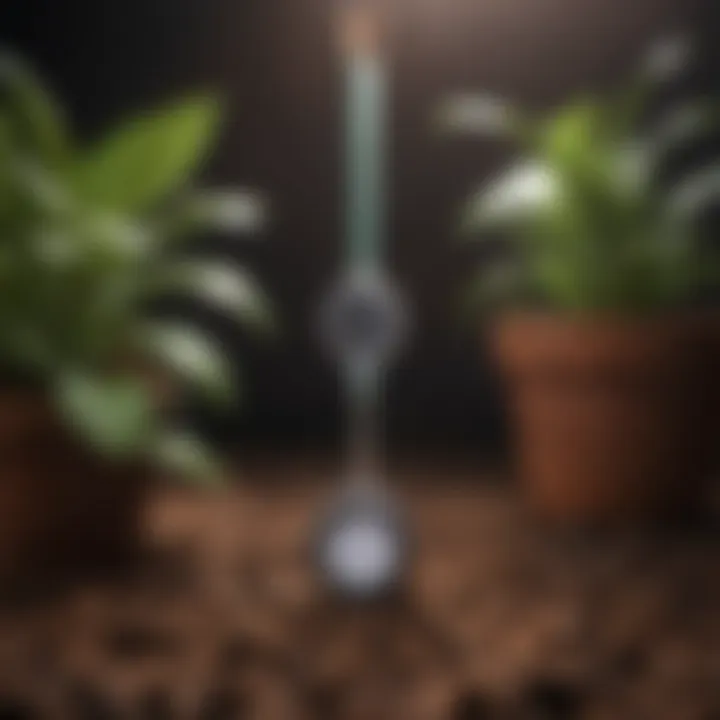Essential Techniques for Watering House Plants


Intro
Watering house plants is more than just a chore; it’s a fundamental component of plant care that can determine the health and vitality of your greenery. Many homeowners, gardeners, and even interior design enthusiasts wonder about the best techniques to ensure their plants thrive. Factors like plant species, environmental conditions, and soil type all play key roles in establishing an effective watering routine.
Understanding these elements is essential to developing a sustainable practice that not only nurtures plants but also minimizes water waste. This article will break down various strategies and practical tips that can be tailored to different house plant varieties. By the end, readers will have a clear framework to follow for watering, ultimately fostering a symbiotic relationship between themselves and their plants.
Understanding Plant Watering Needs
Watering is essential for plant health, but understanding the specific needs of your house plants can be challenging. Root systems, water retention of soil, and the growing environment play critical roles in how much water a plant requires. Knowing these factors ensures that you will not only enhance the appearance of your plants, but also extend their lifespan. This section dives into the critical elements influencing plant watering needs.
Factors Affecting Water Requirements
Plant species
Different plant species have unique water requirements. For instance, succulents like Aloe Vera thrive in dry conditions, needing less water compared to tropical plants like Fiddle Leaf Fig, which prefer consistently moist soil. The types of roots and leaves are often good indicators of a plant’s needs. Succulents store water in their fleshy leaves, allowing them to survive longer periods without moisture. Conversely, tropical plants have larger leaves, indicating they tend to lose water faster through transpiration. Understanding these nuances helps in selecting the right watering method and frequency, tailoring care to your specific plant species.
Growth stage
The growth stage of a plant is another crucial factor in determining its watering needs. Young plants or seedlings generally require more moisture to support rapid growth, while mature plants may shift to needing less frequent watering. For example, when a plant is in the budding phase, the demand for water increases significantly. Conversely, during dormancy, many plants slow their growth and therefore require less water. Recognizing these stages helps you adjust your watering habits accordingly. This responsiveness ultimately leads to more vigorous growth and a healthier plant.
Environmental conditions
The environment where a plant resides significantly influences its watering needs. Factors such as light exposure, temperature, and humidity levels are vital in determining water requirements. Plants in bright sunlight may dry out faster than those in lower light conditions. Additionally, a warm and dry environment typically escalates the evaporation rate, necessitating more frequent watering. On the other hand, high humidity can reduce evaporation and extend intervals between waterings. Considering these elements allows for informed decisions about when and how much to water.
Signs of Underwatering and Overwatering
Recognizing plant stress signals is vital for proper care. Understanding both underwatering and overwatering signs helps maintain optimal health for house plants.
Leaf discoloration
Leaf discoloration is a direct indicator of plant distress. When a plant is underwatered, the leaves may turn yellow and eventually brown. This occurs because the plant is lacking necessary moisture, halting its ability to perform photosynthesis efficiently. Conversely, a plant suffering from overwatering also exhibits discoloration, often showing brown spots or yellowing leaves caused by root stress or rot. By catching these early signs, you can adjust your watering routine to address the issue promptly.
Wilting or drooping
Wilting or drooping leaves can indicate both underwatering and overwatering. An underwatered plant will exhibit drooping, which is its way of conserving moisture. On the other hand, an overwatered plant may also droop, revealing root issues. The leaves can become mushy or limp due to excessive water saturation. Monitoring for these visual cues allows you to fine-tune your watering habits to watch for plant-specific responses.
Root rot indicators
Root rot is a severe condition where roots become damaged due to prolonged exposure to waterlogged soil. Signs of root rot include a foul odor from the soil and blackened, mushy roots when checked. Healthy roots should appear white or light tan and firm. Early detection is essential; if root rot occurs, immediate action is needed, such as reducing watering frequency or repotting to dryer soil. Recognizing these indicators will prevent significant damage and support a healthy plant growth.
Choosing the Right Watering Method
Choosing the right watering method is crucial for maintaining the health and growth of house plants. Each method has its own set of benefits and considerations. The appropriate choice can save time and resources, while ensuring your plants receive the correct amount of water. Understanding the specific requirements of your plants can lead to effective watering routines that optimize their health.
Drip Irrigation Systems
Overview
Drip irrigation is a method that delivers water directly to the plant roots through a network of tubing and emitters. This system allows for precise water delivery, minimizing evaporation and runoff. Its efficiency makes it a popular choice among both novice and experienced gardeners. One key characteristic of drip irrigation is that it provides a steady supply of moisture, which is essential for many plant types.
Many people appreciate drip irrigation for its ability to maintain consistent soil moisture. This unique feature reduces the risk of both underwatering and overwatering. However, installation may require a bit of upfront effort, which could deter some users.
Benefits
The benefits of using a drip irrigation system include water conservation and enhanced plant health. Its efficient delivery system can save users a significant amount of water compared to traditional watering methods. This method effectively reduces the frequency of watering sessions, freeing up time for other gardening tasks.
Another major advantage is the reduced risk of fungal diseases, as water does not splash onto the leaves, which can create an environment for mold. However, initial costs for setup can be a concern, make sure to weigh initial investment against long-term savings on water and plant health.
Installation Tips
When installing a drip irrigation system, it is important to plan the layout according to the needs of your plants. Start by measuring the distance to each plant and calculating the required tubing length.
Be sure to choose the right emitters for your plants, taking into consideration their individual water requirements. Regular maintenance is crucial for preventing clogs that can disrupt water flow. While this system can be more complex than a simple watering can, the long-term benefits often outweigh the initial challenges.
Watering Cans vs. Garden Hoses
Choosing the Right Tools


Selecting the right tools for watering is essential to ensure your plants thrive. Watering cans are suitable for small indoor plants, as they allow for controlled pouring and minimize spills. They are easy to maneuver and can be used for targeted watering.
On the other hand, garden hoses are ideal for larger collections of plants or outdoor gardens. They can cover larger areas more quickly, but may require careful handling to avoid flooding certain plants. Choosing the right tool is about understanding your plant's needs and your gardening space.
Techniques for Effective Watering
Effective watering techniques can greatly impact plant health. For example, using a watering can allows for precision, helping you direct water exactly where it is needed. Watering slowly enables the soil to absorb moisture without runoff.
When using a garden hose, consider using a nozzle with adjustable settings for varied pressure and flow. Avoid watering on windy days, as this can lead to uneven distribution. Following these techniques can enhance the watering process, ensuring that plants receive adequate moisture without wasting water.
Consistent and efficient watering methods are key to sustainable plant care.
The Role of Soil in Water Retention
Soil plays a critical role in determining the water retention capacity for house plants. The composition of soil influences not only how much water is available to plants but also the rate of drainage and the overall health of the plant. Thus, understanding how different soil types behave and how they interact with moisture is crucial for creating an effective watering strategy. The right soil can enhance plant growth, promote aeration, and ultimately lead to thriving indoor gardens.
Understanding Different Soil Types
Clay Soil
Clay soil is noted for its fine particles and compact structure. It retains moisture for extended periods, making it useful for plants that require a lot of water. The key characteristic of clay soil is its ability to hold nutrients effectively, which is beneficial for many indoor plants. However, it often drains poorly, leading to potential root rot if overwatered. The unique feature of clay soil is that it warms slowly, promoting healthy root development in cooler months. It's important to monitor moisture levels in clay soil carefully to avoid waterlogged conditions.
Sandy Soil
Sandy soil consists of larger particles, giving it a loose texture. This enables good drainage, preventing water stagnation. The key characteristic of sandy soil is its rapid drying ability, which makes it suitable for drought-resistant plants like succulents. The unique feature of sandy soil is that it does not hold nutrients as well as denser soils, so regular fertilization is necessary. Therefore, homeowners should be aware that watering frequency should increase for plants in sandy soil to maintain adequate moisture levels.
Loamy Soil
Loamy soil is a balanced mix of clay, sand, and silt. It provides an ideal environment for most house plants by retaining moisture while allowing excess water to drain. The key characteristic of loamy soil is its excellent nutrient retention and aeration capacity. This makes it a popular choice for gardeners. Its unique feature is that it typically warms quickly, supporting robust growth in various plants. Loamy soil minimizes the risk of both underwatering and overwatering, making it an excellent foundation for successful plant care.
Soil Amendments for Improved Drainage
Organic Matter
Organic matter, such as compost, improves soil structure and boosts its capacity to retain moisture without becoming waterlogged. One of the primary benefits of adding organic matter is its ability to enhance nutrient levels, which is essential for plant health. The unique feature of organic matter is that it provides a slow-release nutrient system. However, it does require regular replenishment as it decomposes over time.
Pumice and Perlite
Pumice and perlite are both volcanic materials that improve soil aeration and drainage. They are lightweight and allow excess moisture to escape while still retaining some water needed for plants. The major benefit of using pumice and perlite is their ability to create an optimal balance of moisture and air in the soil. Both materials are neutral in pH, making them suitable for a variety of plants. However, they may need to be replaced periodically to maintain effectiveness.
Coconut Coir
Coconut coir is a natural fiber derived from the husk of coconuts. It is an increasingly popular soil amendment that retains moisture well while allowing good drainage. The key characteristic of coconut coir is its environmentally friendly nature, appealing to eco-conscious gardeners. Its unique feature is its resistance to compaction, which helps maintain aeration in the soil. However, it can sometimes require additional nutrients since it is low in them naturally.
In sum, understanding the role of soil in water retention is vital for effective plant care. Innovations in soil amendments help optimize the water management practices for various indoor plants.
Through thoughtful selection and combination of these soil types and amendments, one can significantly enhance the growth potential and overall health of house plants.
Timing Your Watering Sessions
Understanding the timing of watering sessions is crucial for optimal plant health. Watering too early or too late can affect plant growth and overall vitality. The right timing can also help to conserve water. Factors like temperature, humidity, and light exposure play significant roles in determining when and how much to water.
Best Times to Water House Plants
Morning vs. evening watering
Watering in the morning is often regarded as the best practice for house plants. Morning watering allows plants to absorb moisture before the heat of the day. This can reduce evaporation loss and ensure the roots receive adequate water. Moreover, watering in the morning gives any excess moisture time to evaporate, which reduces the risk of fungal diseases that can occur with damp leaves overnight.
Evening watering can also be beneficial, particularly in hot climates, as it allows for water to stay in the soil longer without being lost to evaporation. However, this method can lead to damp conditions, which may encourage pests and mold growth.
Advantages of Morning Watering
- Ample moisture absorption during the day
- Reduced risk of diseases related to damp foliage
- Helps with temperature regulation of the plant
Disadvantages of Evening Watering
- Higher risk of fungal infections
- Potential for root rot if the soil stays too wet
Seasonal considerations


Seasonal factors also affect when to water house plants. In summer, high temperatures often mean that plants lose moisture more rapidly, necessitating more frequent watering sessions, often in the morning. Conversely, during winter, the cooler, less humid environment can slow down evaporation, meaning that watering needs may decrease.
Adjusting your watering schedule according to the season helps to maintain the plant's health. For instance, indoor plants may require less water in the winter months; overwatering during this time can lead to root rot due to slow evaporation.
Advantages of Adapting Watering to Seasons
- Prevents overwatering or underwatering
- Promotes healthy growth patterns
Frequency of Watering
Factors influencing frequency
The frequency of watering is influenced by various factors including plant type, pot size, and environmental conditions. Each plant species has unique watering needs based on their natural habitat. For instance, succulents require less frequent watering than tropical plants because they store water.
Other elements like the size and material of the pot, as well as humidity levels, can also affect how often to water. For example, terracotta pots allow for better air exchange and moisture loss, leading to the need for increased watering compared to plastic pots.
Adapting watering frequency to specific plants and conditions can enhance plant health significantly.
Avoiding watering routines
Relying on a strict watering routine can be detrimental to plant care. Consistency in time can lead to waterlogged soil or neglected plants. Instead, it's better to assess the moisture level of the soil before deciding to water.
Using a soil moisture meter or the finger test can provide insights. Stick your finger about 2 inches into the soil; if it feels dry, it's time to water. This practice encourages plant owners to be mindful and adaptive to their plant's needs.
Avoiding rigid routines promotes conscious care and a deeper understanding of individual plant needs.
Techniques for Efficient Watering
Techniques for efficient watering are crucial for maintaining healthy house plants while promoting sustainability. Proper techniques ensure that plants receive an adequate amount of water without excessive waste. This section examines different watering methods tailored for various plant types and systems that can assist in effective watering. Understanding these techniques will help both novice and experienced gardeners establish a more consistent watering routine while minimizing risks related to overwatering or underwatering.
Watering Techniques by Plant Type
Succulents and cacti
Succulents and cacti are unique in their water management capabilities. They are designed to thrive in arid conditions. One key characteristic is their ability to store water in their leaves, stems, or roots. This makes them an attractive option for gardeners who might forget to water occasionally. Their fleshiness allows them to endure drought periods, but it also means they require careful attention to the timing of watering.
Watering these plants is typically infrequent; it depends on their soil's moisture level. A unique feature of succulents and cacti is their preference for dry soil between waterings. Overwatering can lead to root rot, a common danger that necessitates good drainage. Therefore, a method like soaking the soil and letting excess water drain is advisable for these plants.
Tropical plants
Tropical plants tend to thrive in more humid environments where water is plentiful. The key trait of these plants is their need for consistently moist soil; thus, they require a different approach to watering. This constant moisture aids in their growth and prevents stress, making them a popular choice for indoor gardening.
A unique aspect of caring for tropical plants is understanding the balance of humidity and moisture levels. Very well-draining pots with good irrigation systems can be effective here. A drawback can be that these plants are prone to problems like mold if overwatered. Careful monitoring is essential when handling such plants to maintain their health and vibrancy.
Herbs and vegetables
Herbs and vegetables are often chosen for their utility and flavor. The important aspect of these plants is their requirement for regular, consistent moisture to ensure optimal growth. Typically, herbs thrive in well-drained soil but dislike being dry for extended periods.
Therefore, integrating watering techniques like bottom watering can be particularly effective. This method ensures that the roots absorb water while leaving the leaves dry, which is vital for preventing disease. Moreover, vegetables are typically shallow-rooted and benefit from moisture retention at the soil surface. However, gardeners must be cautious, as overwatering can lead to pest issues and fungal problems.
Watering with Systems in Mind
Self-watering pots
Self-watering pots offer a convenient solution for busy owners. A key characteristic of these pots is their water reservoirs at the bottom, allowing plants to absorb what they need over time. This system promotes consistent moisture levels, reducing the risk of neglect. It is especially beneficial for individuals who may forget to water regularly.
The unique feature of self-watering pots lies in their ability to prevent root rot while allowing for air circulation within the soil. However, it's important to check the water level regularly, as these systems can sometimes lead to stagnant water if not managed correctly.
Hydroponics
Hydroponics represents a modern approach to growing plants without soil, relying on nutrient-rich water solutions. One characteristic of this system is its ability to deliver precise nutrients directly to the roots. This can lead to faster growth rates and healthier plants overall. Hydroponics can benefit a wide range of plants, making it appealing to those looking for innovative gardening methods.
However, a downside to hydroponics is the initial setup cost and the need for careful monitoring of nutrient levels and pH. Without appropriate management, plants can experience nutrient deficiencies or toxicities. Understanding the requirements of plants within a hydroponic system is essential for successful outcomes.
Efficient watering techniques can significantly enhance plant health, improve growth, and minimize water waste, aligning with sustainable gardening practices.
Monitoring Water Quality


Monitoring water quality is crucial for the health of house plants. Utilizing poor water quality can lead to numerous issues, impacting plant growth and overall vitality. The types of water used can vary significantly in composition and impurities. By assessing the quality of the water, one ensures that plants receive not just enough moisture, but also beneficial elements essential for their growth.
Assessing Tap Water for House Plants
Mineral content
Mineral content is a significant aspect when assessing tap water. It includes essential nutrients such as calcium, magnesium, and potassium, which are central to plant development. These minerals are vital for various physiological functions, promoting healthy growth and improving resilience against disease.
The presence of a proper mineral balance makes tap water a practical choice in many households. However, excessive mineral content can lead to buildup in the soil, which can be detrimental over time. Monitoring this aspect allows gardeners to provide water that nurtures while avoiding potential long-term damage. Understanding the local water supply's mineral profile can inform watering practices that support sustainable plant care.
Chlorine and other chemicals
Chlorine and other chemicals commonly found in tap water can pose risks to house plants. These substances are used in municipal water supplies to prevent pathogens. Although beneficial in ensuring the water’s safety for human use, high levels of chlorine can harm sensitive plants. The key characteristic of these chemicals lies in their negative effects on plant health if not handled properly.
Using water with high chemical content may result in leaf burn or reduced growth. Thus, it is worth considering letting tap water sit for 24 hours before use. This process allows chlorine to dissipate naturally, making the water safer for plants. Occasionally testing for other chemicals present can also ensure a more tailored watering strategy based on specific water quality concerns.
Alternative Water Sources
Alternative water sources can provide unique benefits when compared to regular tap water. Utilizing these sources can enhance plant health and offer solutions to common watering problems.
Rainwater
Rainwater is an eco-friendly option appreciated for its natural composition. It is generally free from chlorine and contains essential nutrients that plants crave. The key advantage is its soft nature, which prevents mineral buildup in the soil and is less likely to cause root damage. Additionally, rainwater collection promotes sustainability, making it an excellent choice for environmentally-conscious gardeners.
However, it is essential to ensure that catchment systems are clean. Contamination from roof surfaces or storage tanks can introduce unwanted elements. Rainwater can also vary in acidity, so monitoring pH levels is advisable for optimal usage.
Distilled water
Distilled water is often regarded as one of the purest forms of water available. The distillation process removes impurities, including minerals and chemicals, making it a controlled choice for sensitive plants. This purity can help in situations where regular water supply quality is questionable. Distilled water is beneficial as it eliminates the risk of introducing harmful elements.
However, the downside of distilled water is the lack of essential minerals that plants require. Relying solely on distilled water may lead to nutrient deficiencies over time. It is advisable to supplement with fertilizer or mineral amendments when using distilled water frequently.
Using high-quality water can significantly improve the health and longevity of house plants. Carefully assessing and monitoring water quality is not just beneficial but essential.
Final Tips for Successful Plant Care
Successful plant care is a blend of strategies that support the healthy growth and longevity of house plants. In this article, we emphasize final tips that optimize plant care through effective watering and related practices. This section serves to crystallize essential approaches and encourage a holistic understanding of plant health, enhancing the overall experience for gardeners.
One primary element is the creation of a watering schedule, which governs how often and when plants receive water. A consistent schedule can prevent common issues like overwatering or underwatering. Another integral component is the integration of watering with other care practices, like fertilization and pruning. This union ensures plants not only receive enough water but also the nutrients and maintenance needed for thriving health.
Creating a Watering Schedule
Creating a watering schedule allows gardeners to set predictable patterns for watering their plants. This reduces the likelihood of forgetting a watering session and helps establish a rhythm beneficial for plant growth. A well-kept record of watering days can also help in adjusting future schedules based on seasonal changes and plant needs.
Record Keeping
Record keeping is a crucial practice when establishing a watering schedule. Tracking when you water your plants provides insight into their specific needs over time. It allows you to note patterns in water requirements based on changing seasons or growth stages. This systematic approach facilitates adjustments, making it easier to determine when plants might need more or less water.
One of the key characteristics of record keeping is its simplicity. It does not require special skills; a simple notebook or a digital app can suffice. This practice becomes beneficial by giving indicators of your plants' health and hydration needs, thus supporting effective water management.
However, one disadvantage could be the time it requires for entries. It may seem tedious initially, but it pays off in the long run by promoting healthier plants.
Adjustments Based on Observation
Adjustments based on observation are key to improving care practices. By closely observing plants, owners can adapt watering schedules in response to visual cues. Signs such as leaf color, texture, or overall growth patterns can inform about their water needs. This principle reinforces the understanding that gardening is not a rigid activity but rather a responsive one.
The essential characteristic of this practice is its adaptability. Observations guide changes in care, allowing for a more personalized approach. It is beneficial because it engages the gardener and fosters a connection to the plants, leading to more informed care decisions.
But it does come with a unique feature; attentiveness is needed. This demands time and experience as it involves recognizing and interpreting various signs from plants. The upside is that developing this skill leads to a deeper understanding of plant health.Careful observation can sometimes require more effort upfront, but it fosters lasting improvements in plant care and growth.
Integrating Watering with Other Care Practices
Integrating watering with other care practices forms a comprehensive approach to house plant maintenance. This synergy maximizes plant health and growth as it aligns their water needs with nutritional support and physical management.
Fertilization
Fertilization is a vital aspect of integrating care practices. Nutrients from fertilizers stimulate growth, aiding plants in responding to their watering needs. Proper nutrition can lead to more vibrant foliage and stronger root systems, which improve a plant's ability to absorb water efficiently.
The key characteristic of fertilization is its direct impact on growth. It represents a beneficial choice in this article as it not only supports overall plant vitality but also complements watering efforts. However, users must be cautious with fertilization; excessive use can harm plants or lead to nutrient imbalances.
Pruning
Pruning is another essential care practice that enhances the overall health of house plants. Regularly removing dead or damaged leaves improves air circulation and light exposure for the remaining parts of the plant. This process can stimulate new growth, making the plant more efficient in using the water provided.
The unique feature of pruning is its dual function: maintaining aesthetics while supporting health. This practice can sometimes be seen as secondary, but it is critical for optimizing the plant's ability to utilize water effectively. A downside could be the fear of over-pruning, which might damage the plant. Yet, when done appropriately, it is a very beneficial practice to incorporate.















